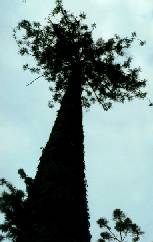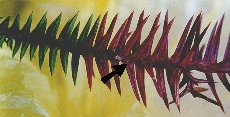- leaf wilt starting from the tree top downwards and from the tips of the branches inwards
- crown more or less defoliated, leader without leaves
- mud packs at base of the stem
- base of the stem with ‘pipe’
- hollow sound of stem when tapped
- trees and seedlings of all ages are affected
Coptotermes elisae (Desneux) (Rhinotermitidae)

- leaf wilt starting at the lower branches moving upwards to the tip of the crown and from the tips of the branches inwards
- distinctive mines in the cortex between the healthy green and wilt yellow or brown area of the branchlets
- mainly 4 to 11 year old trees are infested
- infestation can kill host on long term
Hylurdrectonus araucariae (Schedl) (Scolytidae)

- pin- and shot-holes in stem and timber
- holes are free of sawdust and frass
- sawdust-like powder can be often found on the bark below the holes
- sometimes resin is dripping from the borehole
- wood adjacent to the hole is often stained by the fungal stain
Pin- and shot-hole borers (Platypodidae and Scolytidae)

- surface of leaves and twigs eaten
- branches are defoliated and start to wilt
- infested trees appear brown
- last instar caterpillars can be found at base of the stem
Millionaire moth Milionia isodoxa Prout (Geometridae)
(reproduced from Wylie, F.R., 1974)
- large borehole (Æ 10 - 15 mm) in vicinity of nodes
- attack results in degrade of timber, but can be fatal if attack sustained
- generally injured or pruned trees with resin flow are attacked
- attack clustered on trees older than four years
Hoop pine weevil Vanapa oberthuri (Pouillaude) (Curculionidae)
- larger boreholes in standing or recently felled trees
- attack of stressed and injured trees after fire or infestation with primary pest
- often infested simultaneously by several pests, resulting in the host’s death
- degrade of timber
Curculionidae and/or Cerambycidae wood borers
- stem of seedling debarked or ringbarked at its base
Seedlings damaged by grasshoppers (Orthoptera)